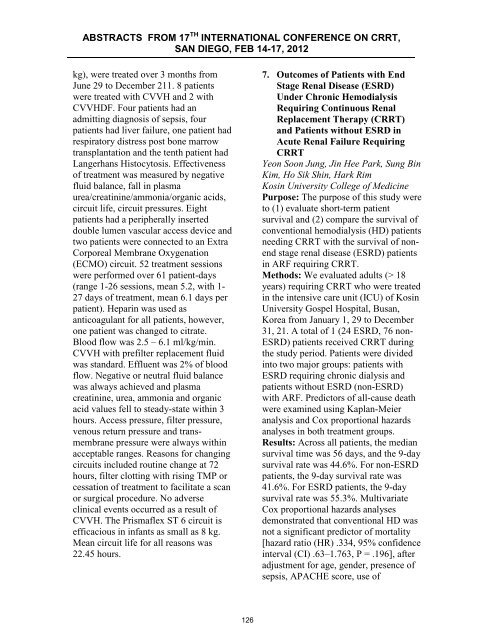ABSTRACTS from 16th International COnference on ... - CRRT Online
ABSTRACTS from 16th International COnference on ... - CRRT Online
ABSTRACTS from 16th International COnference on ... - CRRT Online
You also want an ePaper? Increase the reach of your titles
YUMPU automatically turns print PDFs into web optimized ePapers that Google loves.
<str<strong>on</strong>g>ABSTRACTS</str<strong>on</strong>g> FROM 17 TH INTERNATIONAL CONFERENCE ON <strong>CRRT</strong>,<br />
SAN DIEGO, FEB 14-17, 2012<br />
kg), were treated over 3 m<strong>on</strong>ths <str<strong>on</strong>g>from</str<strong>on</strong>g><br />
June 29 to December 211. 8 patients<br />
were treated with CVVH and 2 with<br />
CVVHDF. Four patients had an<br />
admitting diagnosis of sepsis, four<br />
patients had liver failure, <strong>on</strong>e patient had<br />
respiratory distress post b<strong>on</strong>e marrow<br />
transplantati<strong>on</strong> and the tenth patient had<br />
Langerhans Histocytosis. Effectiveness<br />
of treatment was measured by negative<br />
fluid balance, fall in plasma<br />
urea/creatinine/amm<strong>on</strong>ia/organic acids,<br />
circuit life, circuit pressures. Eight<br />
patients had a peripherally inserted<br />
double lumen vascular access device and<br />
two patients were c<strong>on</strong>nected to an Extra<br />
Corporeal Membrane Oxygenati<strong>on</strong><br />
(ECMO) circuit. 52 treatment sessi<strong>on</strong>s<br />
were performed over 61 patient-days<br />
(range 1-26 sessi<strong>on</strong>s, mean 5.2, with 1-<br />
27 days of treatment, mean 6.1 days per<br />
patient). Heparin was used as<br />
anticoagulant for all patients, however,<br />
<strong>on</strong>e patient was changed to citrate.<br />
Blood flow was 2.5 – 6.1 ml/kg/min.<br />
CVVH with prefilter replacement fluid<br />
was standard. Effluent was 2% of blood<br />
flow. Negative or neutral fluid balance<br />
was always achieved and plasma<br />
creatinine, urea, amm<strong>on</strong>ia and organic<br />
acid values fell to steady-state within 3<br />
hours. Access pressure, filter pressure,<br />
venous return pressure and transmembrane<br />
pressure were always within<br />
acceptable ranges. Reas<strong>on</strong>s for changing<br />
circuits included routine change at 72<br />
hours, filter clotting with rising TMP or<br />
cessati<strong>on</strong> of treatment to facilitate a scan<br />
or surgical procedure. No adverse<br />
clinical events occurred as a result of<br />
CVVH. The Prismaflex ST 6 circuit is<br />
efficacious in infants as small as 8 kg.<br />
Mean circuit life for all reas<strong>on</strong>s was<br />
22.45 hours.<br />
7. Outcomes of Patients with End<br />
Stage Renal Disease (ESRD)<br />
Under Chr<strong>on</strong>ic Hemodialysis<br />
Requiring C<strong>on</strong>tinuous Renal<br />
Replacement Therapy (<strong>CRRT</strong>)<br />
and Patients without ESRD in<br />
Acute Renal Failure Requiring<br />
<strong>CRRT</strong><br />
Ye<strong>on</strong> So<strong>on</strong> Jung, Jin Hee Park, Sung Bin<br />
Kim, Ho Sik Shin, Hark Rim<br />
Kosin University College of Medicine<br />
Purpose: The purpose of this study were<br />
to (1) evaluate short-term patient<br />
survival and (2) compare the survival of<br />
c<strong>on</strong>venti<strong>on</strong>al hemodialysis (HD) patients<br />
needing <strong>CRRT</strong> with the survival of n<strong>on</strong>end<br />
stage renal disease (ESRD) patients<br />
in ARF requiring <strong>CRRT</strong>.<br />
Methods: We evaluated adults (> 18<br />
years) requiring <strong>CRRT</strong> who were treated<br />
in the intensive care unit (ICU) of Kosin<br />
University Gospel Hospital, Busan,<br />
Korea <str<strong>on</strong>g>from</str<strong>on</strong>g> January 1, 29 to December<br />
31, 21. A total of 1 (24 ESRD, 76 n<strong>on</strong>-<br />
ESRD) patients received <strong>CRRT</strong> during<br />
the study period. Patients were divided<br />
into two major groups: patients with<br />
ESRD requiring chr<strong>on</strong>ic dialysis and<br />
patients without ESRD (n<strong>on</strong>-ESRD)<br />
with ARF. Predictors of all-cause death<br />
were examined using Kaplan-Meier<br />
analysis and Cox proporti<strong>on</strong>al hazards<br />
analyses in both treatment groups.<br />
Results: Across all patients, the median<br />
survival time was 56 days, and the 9-day<br />
survival rate was 44.6%. For n<strong>on</strong>-ESRD<br />
patients, the 9-day survival rate was<br />
41.6%. For ESRD patients, the 9-day<br />
survival rate was 55.3%. Multivariate<br />
Cox proporti<strong>on</strong>al hazards analyses<br />
dem<strong>on</strong>strated that c<strong>on</strong>venti<strong>on</strong>al HD was<br />
not a significant predictor of mortality<br />
[hazard ratio (HR) .334, 95% c<strong>on</strong>fidence<br />
interval (CI) .63–1.763, P = .196], after<br />
adjustment for age, gender, presence of<br />
sepsis, APACHE score, use of<br />
126
















